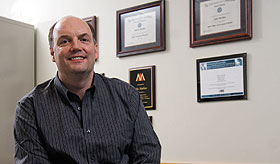  |
| HOME | THIS ISSUE | CALENDAR | GRANTS | BACK ISSUES | < BACK | NEXT > |
Management professor studies dynamics of teamwork by Scott Brinckerhoff - May 5, 2008 | ||||
| What do such diverse settings as a building on fire, a corporate office, a manufacturing floor, or an air traffic control tower have in common? All are places where teamwork occurs. And they are places where new technology is periodically unveiled in the hope that it will improve results. Professor John Mathieu, the Robert Cizik Chair in Manufacturing and Technology Management, has long studied team dynamics in such places, the impact of technology on various tasks, and how managers can improve outcomes. His research has brought him into the worlds of firefighters, nuclear power plants, pharmaceutical salespersons, aerospace engineers, and air traffic controllers, to name a few. Recently, he’s been working with the military to build the most effective teams of American soldiers charged with turning security responsibilities over to their Iraqi counterparts. “Teams are often incredibly dysfunctional,” Mathieu says, even though managers in all sorts of situations readily depend on them. “Teams are not one-size-fits-all, and blending the right people together into an effective team isn’t easy.” As teams have spread through the public and private sectors, they have become increasingly ‘layered,’ Mathieu says. Often, teams work together in what he calls a ‘multi-team system.’ Firefighting illustrates the concept. In a study written with Leslie DeChurch of the University of Central Florida, Mathieu describes firefighters operating in a burning building. To an applied behavioral scientist like Mathieu, such an apparently straightforward exercise in teamwork is highly complex. The various firefighter teams are charged with such functions as search and rescue, fire suppression, on-site medical care, discovery of potentially explosive stored materials, and ventilation. The teams often consist of both volunteers and professional firefighters from more than one municipality. Crowd control and media relations must be addressed. Someone has to be in charge of the entire operation, but that’s often too much for one person, Mathieu says. While the teams are united in their mission, the potential for unintended conflict is real, he adds. If the different teams are not carefully coordinated, they may jeopardize each other. Mathieu describes how a firefighting multi-team system functions ideally: “When the teams first arrive on the scene, the fire suppression and search and rescue teams’ goals are linked sequentially. The fire suppression teams must get water on the fire before search and rescue operations can commence. Second, the nature of the goal hierarchy shifts as the task cycles unfold over time, and the teams become more reciprocally interdependent.”
If team dynamics are this complicated at the site of a single building fire, what does that suggest about the difficulty teams face in a more complex situation? Mathieu uses Hurricane Katrina to illustrate not only the massive challenge of coordinating all the players in the aftermath of such an event, but also to drive home another point: It’s better to avoid getting into a bad situation than to expect a team to bail you out after the fact. “I’m not an expert on Hurricane Katrina,” he says, “but there were clear failures on the management side long before the disaster occurred. Political leaders didn’t take steps that might have minimized the loss of life and property damage, which included not only physical measures but also hiring and training the right people to handle crisis situations.” The chemistry needed to transform a group of individuals into an effective team is complex, but it’s not the only area Mathieu studies. He also researches how technology can be successfully used to improve teamwork. One such study involved some 250 pharmaceutical salespeople who call on doctors. Armed with special laptop computers containing more than 90 screens of relevant data, the drug reps visited each doctor’s office in their areas an average of 25 times a year. The computers contained software that allowed researchers to see how often the reps were using particular screens, giving them a glimpse into how easily salespeople adapt to different selling situations. The study found that putting technology at a salesperson’s fingertips provided measurable benefits that included higher sales, greater customer satisfaction, and smarter salespeople. The laptop selling tools helped both the salesperson and the customer, the study found. But among the sales force, there were still pockets of resistance to the program. Such a response may fly in the face of common sense, but as Mathieu says, “If common sense is so pervasive, why do we still have ‘Dilbert’ cartoons?” |
| ADVANCE HOME UCONN HOME |

